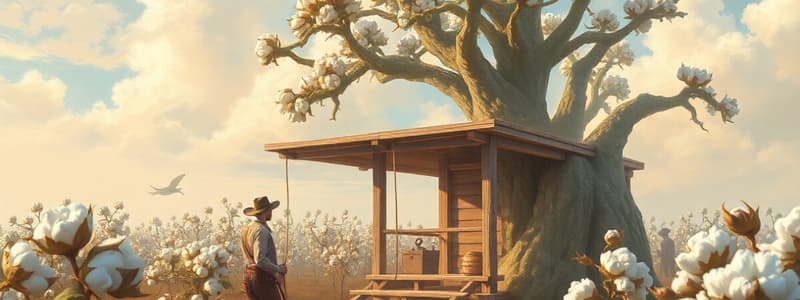Podcast
Questions and Answers
Which group had the largest population increase in Texas between 1850 and 1860?
Which group had the largest population increase in Texas between 1850 and 1860?
- Black Texans (correct)
- Indigenous People
- Mexican Texans
- Women
What was the primary reason for the low number of schools in Texas at mid-century?
What was the primary reason for the low number of schools in Texas at mid-century?
- Distrust in formal education
- Local communities provided only a meager education (correct)
- Inaccessibility of urban areas
- Lack of funding from the government
By 1861, how many miles of railroad track existed in Texas?
By 1861, how many miles of railroad track existed in Texas?
- 400 miles (correct)
- 800 miles
- 200 miles
- 600 miles
What percentage of the population in Austin County, Texas, were slaveholders in 1860?
What percentage of the population in Austin County, Texas, were slaveholders in 1860?
What was a common punishment for slaves who did not meet work expectations?
What was a common punishment for slaves who did not meet work expectations?
Which crop had the highest production among the listed agricultural outputs in Austin County in 1860?
Which crop had the highest production among the listed agricultural outputs in Austin County in 1860?
What main condition did most slaves face regarding their living quarters?
What main condition did most slaves face regarding their living quarters?
Which aspect of community life in Texas saw a notable increase from 1845 to 1860?
Which aspect of community life in Texas saw a notable increase from 1845 to 1860?
Which candidate in the 1857 governor’s race prioritized keeping Texas in the Union?
Which candidate in the 1857 governor’s race prioritized keeping Texas in the Union?
What was a significant outcome of the Texas Troubles in 1860?
What was a significant outcome of the Texas Troubles in 1860?
Which political party in mid-century Texas was primarily composed of slaveholders?
Which political party in mid-century Texas was primarily composed of slaveholders?
In the 1860 Democratic Convention in Charleston, what issue caused a split between the Southern and Northern Democrats?
In the 1860 Democratic Convention in Charleston, what issue caused a split between the Southern and Northern Democrats?
Who was the Republican candidate nominated in Chicago, Illinois?
Who was the Republican candidate nominated in Chicago, Illinois?
What fear spread across North Texas after the fires in Dallas and Denton in 1860?
What fear spread across North Texas after the fires in Dallas and Denton in 1860?
Which platform did Southern Democrats adopt after splitting from the mainstream Democratic Party?
Which platform did Southern Democrats adopt after splitting from the mainstream Democratic Party?
What was a common characteristic of the Know-Nothings in Texas politics?
What was a common characteristic of the Know-Nothings in Texas politics?
Flashcards are hidden until you start studying
Study Notes
Texas History (Pre-1861)
- Indigenous populations inhabited Texas before European arrival in 1528.
- Spanish control of Texas lasted from 1528 to 1821.
- Mexican control followed, from 1821 to 1836, a period marked by slavery.
- The Republic of Texas existed from 1836 to 1845.
- The U.S.-Mexican War impacted Texas from 1846 to 1848.
Texas Cotton Production & Society (Mid-19th Century)
- Significant cotton production growth between 1850 and 1860.
- 1850: 58,000 cotton bales (23 million lbs), 58,161 Black Texans.
- 1860: 431,463 cotton bales (173 million lbs), 182,566 Black Texans.
- Texas population grew from 212,592 in 1850 to 604,215 in 1860.
- Mexican Texans numbered between 13,900 and 23,200.
- Limited educational opportunities; local communities provided basic education.
- Newspaper growth: 9 in 1845, 89 in 1860.
- Religious services often provided by itinerant preachers.
- Transportation was limited; inconsistent river routes, dangerous stagecoach lines, and minimal railroad development (400 miles by 1861, mostly from Houston).
Slavery in Texas (Mid-19th Century)
- Austin County, Texas (1860): Population 10,139, including 3,914 slaves (38.6%) and 324 slaveholders (5.2%).
- Average slave ownership: 12 slaves per owner; 46 owners had at least 20 slaves; 6 owned at least 100.
- Most slaves worked in fields (cotton, rice, tobacco, corn, wheat, cattle) or as domestic servants.
- Slaves worked long hours (sunrise to sunset), with minimal breaks; punishments were common.
- Many slaves attended church services with their owners but were forbidden from learning to read and write.
- Some plantation owners employed overseers to manage slave labor and discipline.
- Lynch was brought in from the Caribbean to improve discipline.
- Approximately 4,000,000 slaves lived in the United States by the mid-19th century.
Abolitionism and Texas Politics (Mid-19th Century)
- Debate over slavery's role in Texas: The Constitution didn't allow the federal government to directly abolish slavery in individual states.
- 1857 gubernatorial race: Hardin R. Runnels (reopen the African slave trade) defeated Sam Houston (remain in the Union).
- 1859 gubernatorial race: Sam Houston (blamed Runnels for Indian raids) defeated Runnels (slavery as the priority).
- Dallas and Denton fires in July 1860 sparked fears of slave insurrection, leading to over 50 lynchings.
- Political parties in Texas: Democrats (slaveholders), Whigs (pro-union), Know-Nothings (nativists), Republicans (abolitionist).
- 1860 Democratic Convention splits over slavery issue, leading to multiple candidates.
- Republicans nominated Abraham Lincoln, whose anti-slavery stance fueled Southern secession.
- Texas's decision to secede was influenced by slavery and Indian raids.
Studying That Suits You
Use AI to generate personalized quizzes and flashcards to suit your learning preferences.




